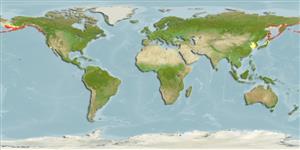>
Perciformes/Zoarcoidei (Eelpouts and pricklebacks) >
Stichaeidae (Pricklebacks) > Alectriinae
Etymology: Alectrias: Greek, alektros, -os, -on = single, married in illegal or unhappy marriage (Ref. 45335).
More on author: Pallas.
Environment: milieu / climate zone / Tiefenbereich / distribution range
Ökologie
seewasser demersal; tiefenbereich 0 - 100 m (Ref. 50550), usually ? - 50 m (Ref. 51666). Temperate
Northwest Pacific: Commander Islands and southeastern Kamchatka to the Sea of Okhotsk and northern Sea of Japan. Northeast Pacific: Alaska.
Size / Gewicht / Alter
Geschlechtsreife: Lm ? range ? - ? cm
Max length : 10.0 cm SL Männchen/unbestimmt; (Ref. 43239)
Kurzbeschreibung
Bestimmungsschlüssel | Morphologie | Morphometrie
Rückenflossenstacheln (insgesamt) : 59 - 66; Rückenflossenweichstrahlen (insgesamt) : 0; Afterflossenstacheln: 1; Afterflossenweichstrahlen: 41 - 45; Wirbelzahl: 64 - 70. Gray to nearly black to bright spotted with patterns; usually a wavy line extending along back, separating dark portion from lighter spots that continue onto dorsal fin (Ref. 43939). Caudal fin rounded.
Mainly intertidal, but may be found at depths as much as 100 m (Ref. 43939); typically found shallower than 50 meters (Ref. 51666). Often in bays with pebble-rock debris bottoms (Ref. 43939). Oviparous, eggs are guarded by the female parent (Ref. 58332).
Life cycle and mating behavior
Geschlechtsreife | Fortpflanzung | Ablaichen | Eier | Fecundity | Larven
Mecklenburg, C.W., T.A. Mecklenburg and L.K. Thorsteinson, 2002. Fishes of Alaska. American Fisheries Society, Bethesda, Maryland. xxxvii +1037 p. (Ref. 43939)
IUCN Rote Liste Status (Ref. 130435: Version 2024-2)
Bedrohung für Menschen
Harmless
Nutzung durch Menschen
Tools
Zusatzinformationen
Download XML
Internet Quellen
Estimates based on models
Preferred temperature (Ref.
123201): 2.3 - 12.9, mean 6 °C (based on 248 cells).
Phylogenetic diversity index (Ref.
82804): PD
50 = 0.5156 [Uniqueness, from 0.5 = low to 2.0 = high].
Bayesian length-weight: a=0.01000 (0.00244 - 0.04107), b=3.04 (2.81 - 3.27), in cm total length, based on all LWR estimates for this body shape (Ref.
93245).
Trophic level (Ref.
69278): 3.1 ±0.44 se; based on food items.
Widerstandsfähigkeit (Ref.
120179): mittel, Verdopplung der Population dauert 1,4 - 4,4 Jahre. (Preliminary K or Fecundity.).
Fishing Vulnerability (Ref.
59153): Low vulnerability (10 of 100).
🛈
